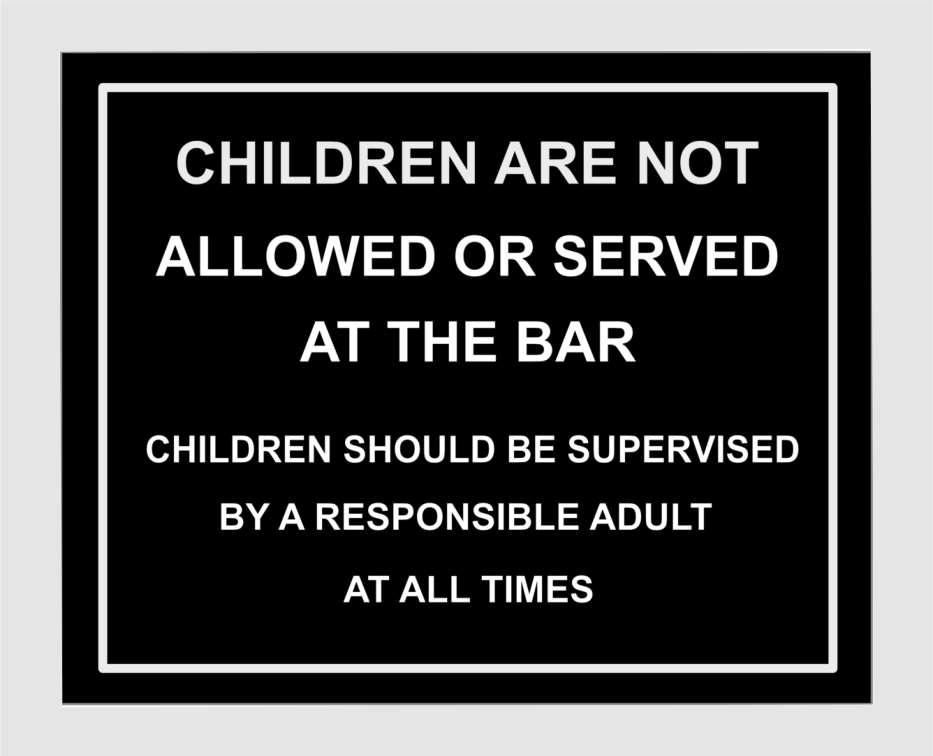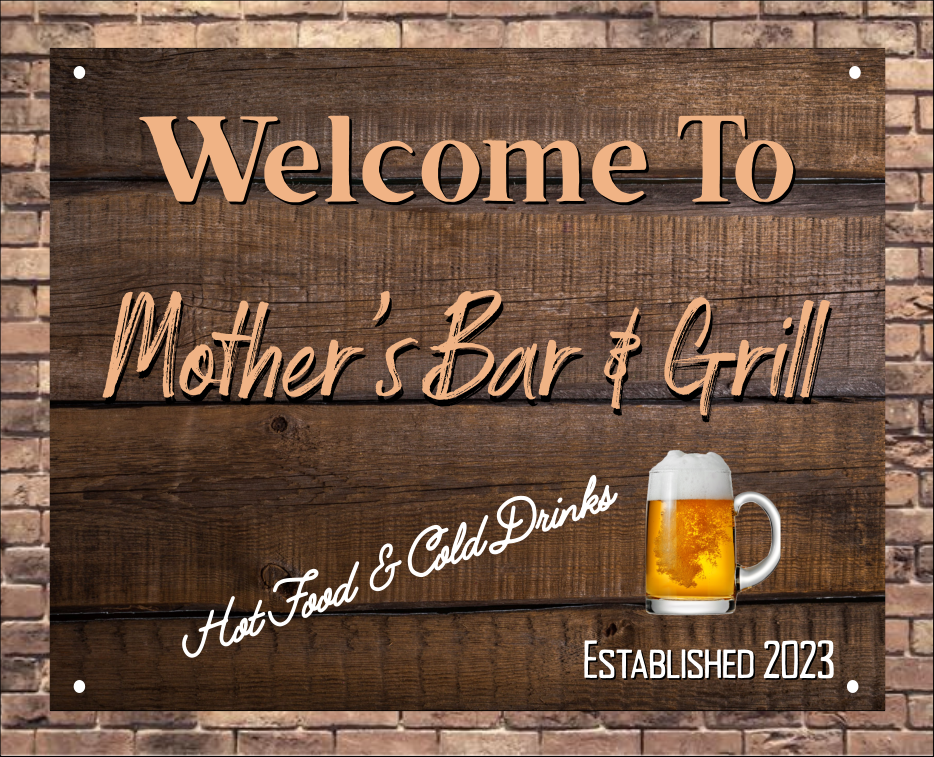There are different sizes for bar signs depending on the function of their design, the location they're put and how they appear. Here is a brief explanation as to how the size of bar signs affects their function and aesthetic appeal. Large Signs
Draw attention and become as a focal focus.
Uses: Exterior signs such as main branding signs or walls with features.
Placement is typically over entrances, outside bars, or on walls with large areas to draw customers.
Examples: Big neon signs, large vintage-style signs, or expansive mural-style signs.
2. Medium Signs
The purpose of the wall art is to offer information and enhance decor, without occupying space.
Uses: Signs for directional signage, menu boards as well as promotional display.
Location: Placed in a way that is easy to see but not overwhelming. For example behind the bar, over seating areas or on walls that are feature.
A few examples are signs of medium size for daily specials; steel signs with a bar's logo or themed decorative signs.
3. Small Signs
For adding subtle decorative details and/or specific particulars.
Uses include table signs as well as small decorative objects or labels.
The table or on shelves where close-up view is desired.
For instance, table number signs, tiny framed quotes or menus for drinks.
Size Factors
Visibility
Signs that are big: These signs can be observed from a distance and will attract passersby. They also signalize the existence of an establishment.
Medium signs balance visibility with space efficiency to provide vital information without overpowering the design.
Small Signs - Ideal for information or details that is close up. They are able to be positioned at eye or table level to improve the experience of patrons.
Proportion
Large Signs: They should be proportionately large so as to not overwhelm smaller areas. Ideal for large or open spaces.
Medium Signs: Perfect for use in the interior, they can be placed wherever you want them to be.
Small signs: Ideal to add details and fit into smaller spaces, without clutter.
Impact
Signs that are large in size makes a bold and imposing statement. This can be an important aspect of branding. Bar signs are utilized to establish a specific tone.
Medium Signs are a good mix of the appearance and the visibility. They create the ambience, while also conveying important messages.
Small signs can add a touch of the look and feel of a sign which create a better visual experience.
Practicality
Large Signs (Large) Large Signs (Large): They require extensive mounting options and are typically more costly because of their size.
Medium Signs - Easy to set up and move with the ability to change design.
Small Signs. Flexible, simple to update and replace. Perfect for environments that are dynamic.
Functionality
Large Signs: primarily used for visibility and attraction.
Medium Signs: They're both functional and decorative. They are a source of vital information while also adding aesthetics.
Small Signs: Primarily functional for providing information in detail, but also contribute to the overall theme and decor in a subtle manner.
The dimension of bar signage is determined by their purpose as well as the design and impact they want to have on the patrons. The balance between these factors ensures that the signs effectively contribute to the ambience of the bar as well as the operational requirements. View the recommended bar signs for home blog for website info including large personalised bar signs, bar wall signs, personalised cocktail sign, bar signs for home, sign for garden bar, home garden bar signs, hanging bar sign, modern pub sign, bar sign outdoor, hanging pub signs personalised and more.

What Is The Difference Between Bar Signs In Terms Of Durability?
The life expectancy of bar signs may vary depending on the material and construction and the purpose for which they are intended. Here's a look at how bar signs differ in terms of their durability. Material
Metal: Signs made of aluminum, steel or other metals are strong and impervious to weathering and weathering, which makes them ideal for outdoor use.
Wood: Signs made from solid wood are sturdy but may require maintenance to prevent rotting or warping, especially in outdoor environments.
Acrylic Signs made of acrylic are lightweight and durable. acrylic signs are not susceptible to shattering and can stand up to outdoor exposure.
Neon and LED signs Neon is brittle and vulnerable to damage. LED signs however are tougher and more energy efficient.
2. Weather Resistance
Outdoor Signs for the outdoors. Materials and coatings should be resistant to fade, corrosion and water damage.
Indoor signs: Even though they are not exposed to the elements, indoor signs should be able to withstand humidity, temperature fluctuations and wear.
3. Construction
Signs made of solid construction, like reinforced corners and durable mounting hardware, are more resistant to damage.
Signs with sealed electrical components: Signs that have sealed electrical components (for lit signs) are less prone to water damage.
4. Maintenance Requirements
Low maintenance: Bar owners will find it more convenient to choose signs that only require occasional cleaning or only minimal maintenance.
High Maintenance Signs that have intricate designs, fragile materials, or require special maintenance are costly and time-consuming.
5. Location
Indoor Signs: Because indoor signs are typically less vulnerable to environmental hazards Their requirements for durability may be less than that of outdoor signs.
Outdoor Signs Outdoor signs require more strength to withstand the effects of sunshine, rain, wind and temperature variations.
6. Impact Resistance
Signs designed for high traffic locations or those that might be subjected to impact (e.g. bars with a lot of traffic) must be constructed with tough materials that stand up to scratching or denting.
Surfaces that are protected: Signs that have laminates or coatings that protect them are less susceptible to damage caused through vandalism, spills or scratches.
7. Longevity
Durability. Signs that are durable will last for years and never be damaged, giving bar owners a high return on their investment.
Signs used for short-term promotions or events don't necessarily need to be as durable as signs intended for permanent use.
8. Lighting
Lighting Components. Signs that use Neon or LED lighting must have components that are durable and last for a long time.
9. Environmental Impact
Signs made with recycled or sustainable materials are less likely to have an environmental impact, but are sturdy and practical.
10. Customization
Customized Options: Signs that provide custom options could have different degrees of durability based on the materials and production methods used.
Durability comes with many advantages
Durability: Durable signage requires less maintenance and replacement which reduces costs in the long term.
Brand Image: High-quality, durable signs reflect positively on the bar's brand image and professionalism.
Satisfaction of customers: Clean quality signs can contribute to the customer's satisfaction and increase the ambience of the bar.
Bar owners can select signs that are durable enough to last for a long time and enhances their establishment by weighing aspects like construction, material, placement, and maintenance. Read the most popular bar signs for home bar hints for more tips including the staying inn sign, bar signs, bar signs for garden, small pub signs, home made bar sign, personalised pub, modern pub sign, personalised cocktail bar sign, bespoke bar signs, pub signs for home bars and more.

What Is The Difference Between Bar Signs From Regulations?
The bar sign is subject to different regulations, imposed by the local as well as federal and state authorities to ensure the health of the public, aesthetic standards, compliance with zoning laws, and to ensure public welfare. Below is how bar signs differ according to the rules: 1. Size and Positioning Regulations
Zoning Laws - Regulations establish the place of signage, their size and height as well as their distance from road lines nearby buildings, property boundaries.
Historic Districts. Signs of all sizes or designs and materials may be prohibited to protect the historical character.
2. Illumination Restrictions
Light Pollution: To minimize light pollution and to preserve nighttime settings, laws may restrict the intensity of the signs, their hue and their duration.
Safety concerns: Signs should not create glare that can hinder pedestrians and drivers.
3. Content of the signage
Alcohol Advertising Certain jurisdictions have limitations on advertising for alcohol, prohibiting certain content or imagery that may appeal to minors or promote the consumption of alcohol to an excessive level.
Health warnings. Laws may require to display signs that warn of risks associated with smoking cigarettes or alcohol consumption.
4. Historic Preservation Regulations
Architectural Compatibility Signs must match the character and style of the historical district. This often requires approval by preservation boards or commissions.
Signs are subject to restrictions by their materials, designs, or colors in order to protect the integrity of history.
5. Sign Permitting Process
Permit requirements: Before installing or changing signs the bar owners have to obtain permits. This could mean submitting plans, paying fees and getting approval from local authorities.
Code Compliance: To ensure public security and accessibility Signs must be in compliance with building codes, accessibility regulations, and safety standards.
6. Sign Removal and Maintenance
Maintenance requirements: It's the bar's responsibility to keep their signage in good working order. This includes ensuring they are structurally sound, safe, and comply with all laws.
Signs that are abandoned: To avoid blight in the area, and to preserve its beauty, rules could be in place to govern the removal.
7. Digital Signage Regulations
Content Restrictions. The law may limit what images can be displayed on digital signs. For example they could ban flashing lights, or offensive images.
Limits to operation: Regulations could restrict the intensity, speed or frequency with the time digital signs change in order to minimize visual noise.
8. Penalties and Enforcement
Inspections. Local authorities conduct regular inspections of signs to ensure compliance. For violations, citations are issued.
Penalties: For non-compliance, penalties may include citations or fines. These could also be orders to remove signs or alter them, or even legal actions.
9. Sign Variance Process
Bar Owners Can Apply for Variances: Bar owners are able to apply for variances in order to differ from the sign regulations that are standard. They must demonstrate they have a valid justification for their decision and mitigate any negative impacts on aesthetics, safety, or security.
Public Input : Variances can require hearings in the community or involvement from business associations or property owners.
10. Community Input & Engagement
Public Consultation: Some jurisdictions consult with the community in order to create regulations for signage. This may be done through public meetings, surveys, or stakeholder consultations.
Community Benefits : Sign Regulations may include provisions for promoting local businesses or revitalize the neighborhood.
By understanding and complying with signs regulations, bar owners can ensure that their signage improves the aesthetic appeal of their establishment. improve the overall appearance of the community, and comply with the law, thus reducing the possibility of fines or penalties, as well as legal disputes. See the top rated make a pub sign blog for more examples including pub signs made, pub signs made, bar sign hanging, personalised pub signs, make a pub sign, small pub signs, home made bar sign, personalised hanging pub signs, pub signs, make a pub sign and more.
